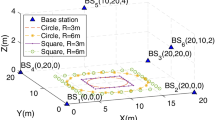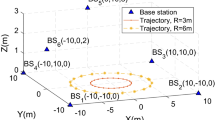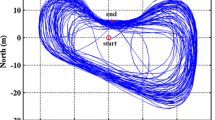Abstract
Resolving carrier phase ambiguities is the prerequisite for achieving high-precision positioning applications based on pseudolite positioning systems. To improve the probability of resolving ambiguities, pseudolite observations are usually integrated with measurements from inertial navigation systems (INS) in an “on-the-fly” ambiguity resolution (OTF-AR) process. Traditional OTF-AR for pseudolite/INS integration is realized by approximately linearizing a nonlinear problem based on the initial states. However, due to the close distance between base stations and the receiver, the measurement model of a pseudolite positioning system is always highly nonlinear. If the initial position is not sufficiently accurate, significant truncation errors may occur, leading to convergence difficulties or even AR failure in traditional OTF-AR. We present an improved OTF-AR method for pseudolite/INS integration. In the proposed method, pseudolite measurements and inertial measurements are combined in a tight integration mode. In addition, double-difference square observations are utilized to reduce the effect of truncation errors, and the reliability of the resolved ambiguities is improved significantly. To validate the proposed method, simulations and real-world experiments are designed and demonstrated. Simulations and experimental results show that, compared to existing methods, the proposed method converges more rapidly and own stronger robustness. It can achieve accurate ambiguity resolution, even when severe initial state errors are present.













Similar content being viewed by others
Data availability
The datasets that support the findings of this research are available from the corresponding author on reasonable request.
References
BarItzhack IY, Berman N (1987) Control theoretic approach to inertial navigation systems. J Guid Control Dyn 11(3):237–245
Bonenberg L, Hancock C, Roberts GW (2010) Indoor multipath effect study on the Locata system. Journal of Applied Geodesy 4(3):137–143
Carcanague S, Julien O, Vigneau W, Macabiau C (2013) Low-cost single-frequency GPS/GLONASS RTK for road users. In: Proceedings of ION PNT 2013. Institute of Navigation, Honolulu, Hawaii, USA, April 23–25, pp 168–184
Choudhury M.M, Rizos C, Harvey B (2009) A survey of techniques and algorithms in deformation monitoring applications and the use of the Locata technology for such applications. In: Proceedings of ION GNSS 2009. Institute of Navigation, Savannah, Georgia, USA, September 22–25, pp 668–678
Cobb HS (1997) GPS pseudolites: theory, design, and applications. Dissertation, Stanford University
Dai L, Zhang J, Rizos C, Han S, Wang J (2000) GPS and pseudolite integration for deformation monitoring applications. In: Proceedings ION GPS 2000. Institute of Navigation, Salt Lake City, Utah, USA, September 19–22, pp 1–8
Goshen-Meskin D, BarItzhack IY (1992) Unified approach to inertial navigation system error modeling. J Guid Control Dyn 15(3):648–653
Han H, Wang J, Wang J, Tan X (2015) Performance analysis on carrier phase-based tightly-coupled GPS/BDS/INS integration in GNSS degraded and denied environments. Sensors 15(4):8685–8711
Han H, Wang J, Wang J, Moraleda AH (2017) Reliable partial ambiguity resolution for single-frequency GPS/BDS and INS integration. GPS Solutions 21(1):251–264
Hein GW (2020) Status, perspectives and trends of satellite navigation. Satell Navig 1(2):22. https://doi.org/10.1186/s43020-020-00023-x
Jiang W, Li Y, Rizos C (2013) On-the-fly Locata/inertial navigation system integration for precise maritime application. Meas Sci Technol 24(10):105104
Jiang W, Li Y, Rizos C (2014) On-the-fly indoor positioning and attitude determination using terrestrial ranging signals. In: Proceedings of ION GNSS 2014. Institute of Navigation, Tampa, Florida, USA, September 8–12, pp 3222–3230
Jiang W (2015) Seamless precise positioning through the integration of satellite, terrestrial ranging and inertial technologies. Dissertation, the University of New South Wales
Kee C, Kim J, So H, Jun H, Parkinson B, Hansen WW (2004) Effect of the error in lineof sight unit vector on the accuracy of GPS and pseudolite navigation system. Comput Math Appl 48(5–6):779–787
Kiran S, Bartone CG (2004) Flight-test results of an integrated wideband-only airport pseudolite for the category IV/III local area augmentation system. IEEE Trans Aerospace Electron Syst 40(2):734–741
Krüger G, Springer R, Lechner W (1994) Global navigation satellite systems (GNSS). Comput Electron Agric 11(1):3–21
Kuusniemi H, Lachapelle G (2004) GNSS signal reliability testing in urban and indoor environments. In: Proceedings of ION NTM 2004. Institute of Navigation, San Diego, California, USA, January 26–28, pp 210–224
Lee HK, Park WY (2005) High accuracy of GPS/pseudolite/INS integration: carrier phase measurement processing Issues. KSCE J Civ Eng 9(3):261–270
Lee HK, Wang J, Rizos C (2005) An integer ambiguity resolution procedure for GPS/pseudolite/INS integration. J Geodesy 79(4):242–255
Lee T, Kim C, Jeon S, Jeon S, Kim G, Kee C (2010) Pedestrian indoor navigation algorithm based on the pseudolite and low-cost IMU with magnetometers including in-flight calibration. In: Proceedings of ION ITM 2010. Institute of Navigation, San Diego, California, USA, January 25–27, pp 230–235
LeMaster EA (2002) Self-calibrating pseudolite arrays: theory and experiment. Dissertation, Stanford University
Montillet J, Roberts GW, Hancock C, Meng X, Ogundipe O, Barnes J (2009) Deploying a Locata network to enable precise positioning in urban canyons. J Geodesy 83(2):91–103
Politi N, Yong L, Faisal K, Mazher C, Bertsch J, Cheong J, Rizos C (2009) Locata: A new technology for high precision positioning. In: European navigation conference 2009. The European Group of Institutes of Navigation, Naples, Italy, May 3–6, pp 1–11
Puengnim A, Patino-Studencka L, Thielecke J, Rohmer G (2013) Precise positioning for virtually synchronized pseudolite system. In: Proceedings of the 2013 international conference on indoor positioning and indoor navigation (IPIN). IEEE, Belfort-Montbeliard, France, October, pp 1–8
Shockley JA (2005) Estimation and mitigation of unmodeled errors for a pseudolite based reference system. Thesis, Air Force Institute of Technology
Wang T, Yao Z, Yun S, Lu M (2016) A new network-based synchronization approach for pseudolite and improvements on robustness. In: Proceedings ION GNSS 2016. Institute of Navigation, Portland, Oregon, USA, September 12–16, pp 838–844
Wang T, Yao Z, Lu M (2018) On-the-fly ambiguity resolution based on double-differential square observation sensors. Sensors 18(8):2495
Wang T, Yao Z, Lu M (2019) On-the-fly ambiguity resolution involving only carrier phase measurements for stand-alone ground-based positioning systems. GPS Solut 23(2):23–36
Yan G, Wang J, Zhou X (2015) High-precision simulator for strapdown inertial navigation systems based on real dynamics from GNSS and IMU integration. In: Proceedings China satellite navigation conference (CSNC) 2015. Springer, Xi’an, China, May 13–15, pp 789–799
Yun S, Yao Z, Wang T, Su J, Lu M (2019) On-the-fly ambiguity resolution without requirements of priori position information for passive pseudolite receiver. In: Proceedings of ION ITM 2019. Institute of Navigation, Reston, Virginia, USA, January 28–31, pp 598–607
Acknowledgements
This research is supported by the National Natural Science Foundation of China, under Grant No. 61771272, and Beijing National Research Center for Information Science and Technology, under Grant No. BNR2021RC01015.
Author information
Authors and Affiliations
Corresponding author
Additional information
Publisher's Note
Springer Nature remains neutral with regard to jurisdictional claims in published maps and institutional affiliations.
Appendix: Computation method of the INS error matrix
Appendix: Computation method of the INS error matrix
When calculating (4), the INS error matrix \({\mathbf{F}}_{{{\text{ie}}}}\) is an essential part. The INS error matrix \({\mathbf{F}}_{{{\text{ie}}}}\) is calculated through the following equalities (Goshen-Meskin and BarItzhack 1992):
where
where \(\Omega\) is the earth rotation rate, \(L\), \(\lambda\) and \(h\) are latitude, longitude and altitude values, \(f_{{\text{E}}}\), \(f_{{\text{N}}}\) and \(f_{{\text{U}}}\) are components of the accelerometer specific force vector \({\mathbf{f}}^{{\text{n}}}\) in east, north and up directions.
Rights and permissions
About this article
Cite this article
Yun, S., Yao, Z. & Lu, M. On-the-fly ambiguity resolution method for pseudolite/INS integration based on double-difference square observations. GPS Solut 25, 137 (2021). https://doi.org/10.1007/s10291-021-01171-6
Received:
Accepted:
Published:
DOI: https://doi.org/10.1007/s10291-021-01171-6




